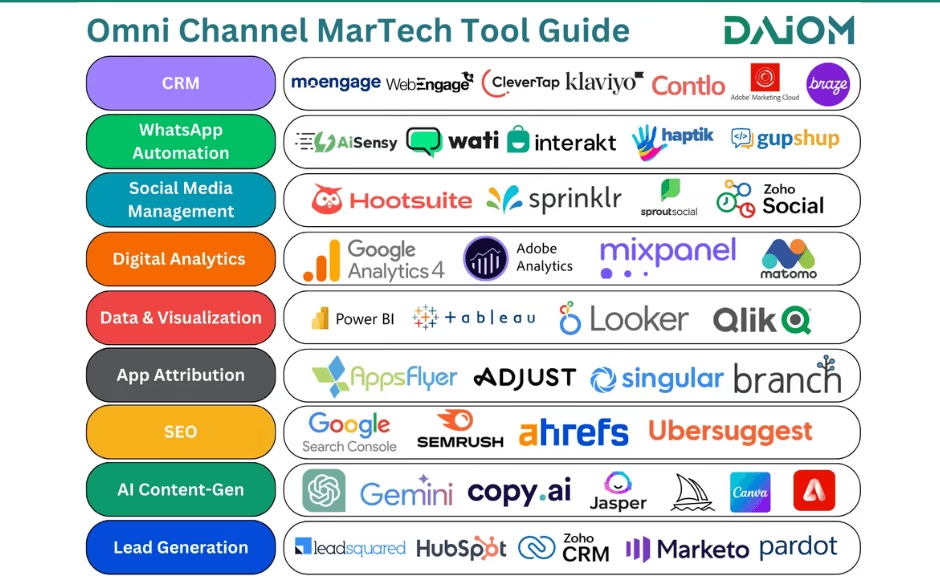Digital marketing now commands over 70% of total marketing spend, and to drive its effectiveness, the use of technology, data, and analytics is key.
However, navigating this complex Martech ecosystem—with its overwhelming array of over 14,000 tools—can be daunting for those attempting to build and manage it independently.
Strategic selection and integration of the right technologies are essential for maximizing ROI and staying competitive in this digital age.
This blog is focused on demystifying the Martech world and helping you choose the key areas and tools to invest in for optimal results.
The modern marketer is an experimenter, a lover of data, a content creator, a justifier of ROI.
Kim Walsh
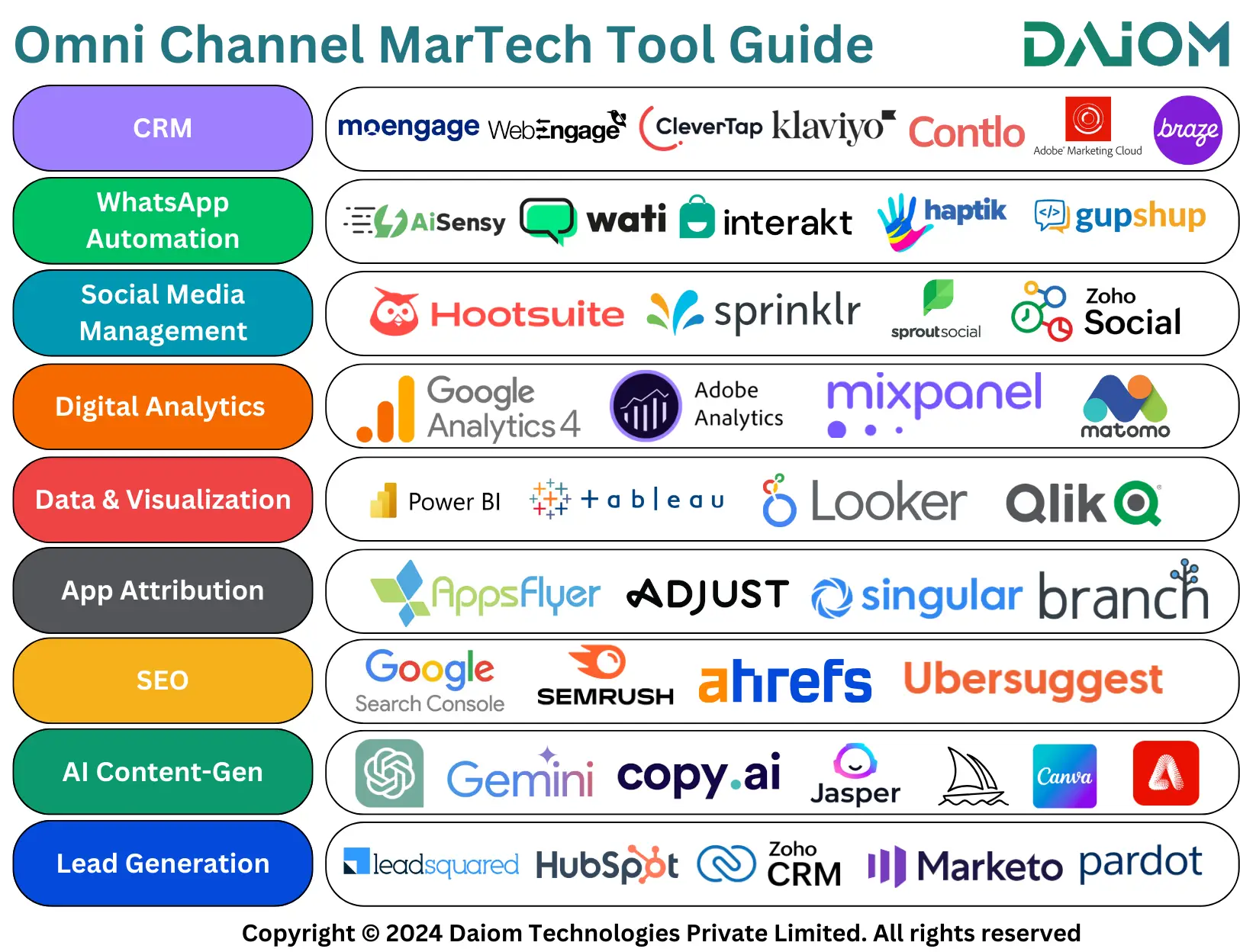
The Importance of MarTech
MarTech has become a vital asset for businesses seeking marketing success. Its importance lies in its ability to streamline processes, enhance customer experiences, and drive better results. Here’s why MarTech matters:
- Efficiency: MarTech automates repetitive tasks, freeing up time and resources for strategic initiatives. From social scheduling to email campaigns, automation enables teams to accomplish more.
- Data-Driven Insights: Powerful analytics provide deep insights into customer behaviour, campaign performance, and market trends. These data-driven insights inform optimised marketing strategies.
- Customer Experience: MarTech facilitates personalised interactions across touchpoints by leveraging customer data to deliver tailored content, offers, and experiences that resonate.
- Increased ROI: By streamlining the processes, optimising campaigns, and delivering personalization, MarTech ultimately drives better return on the marketing investments of a company.
- Competitive Edge: Businesses that effectively use MarTech can respond faster to market shifts, adapt to customer preferences, and deliver superior experiences over competitors.
As the digital landscape evolves, the importance of MarTech continues to grow.
Landscape of MarTech
Before getting into the categories of MarTech and its use cases, let’s have a look at the landscape of MarTech and truly understand how many tools are available for businesses and marketers to use.
Below image of MarTech landscape is created by cheifmartec & Martech Tribe for their annual report – “The State of MarTech 2024”.
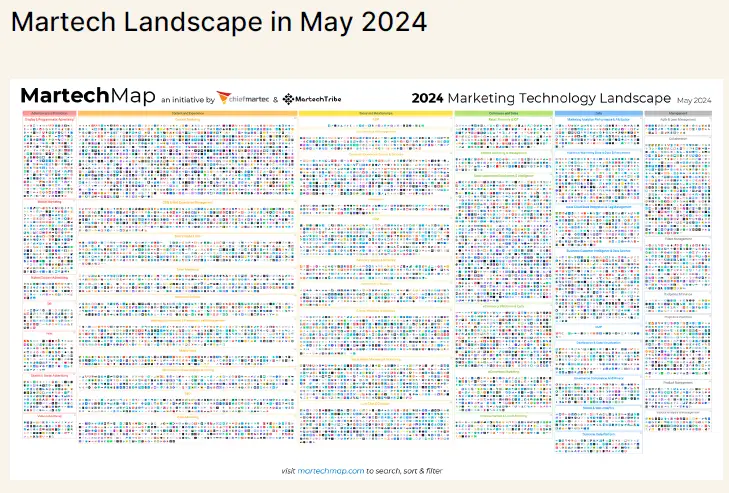
MarTech solutions had a total sum of 150 product offerings in 2012 and now it has over 14,000 product offerings in 2024. Since its first landscape in 2011, the overall count of martech solutions has grown a mind-boggling 9,304%. Annualised, the industry has expanded at a 41.8% CAGR.
Consumers Platform Preferences
To better understand the consumer preferences, a survey was conducted by cheifmartec & MarTech Tribe in 2024 among the MarTech community members.
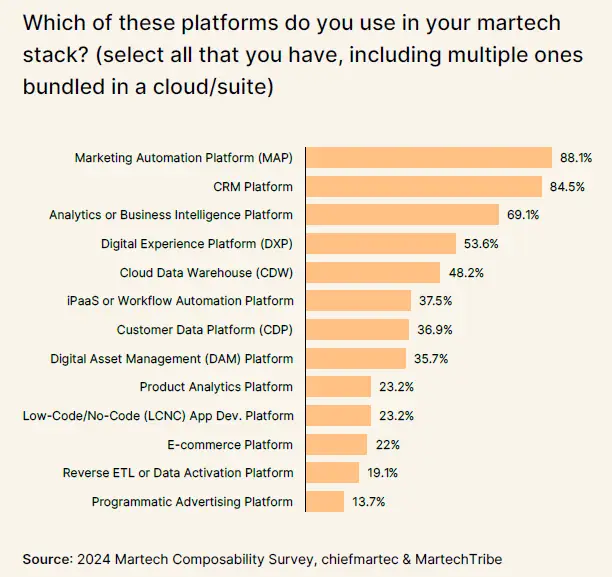
The most common platforms found in the participants’ martech stacks were
- Marketing Automation Platform (MAP) or Customer Engagement Platform (CEP) (88.1%)
- CRM Platform (84.5%)
- Analytics or Business Intelligence Platform (69.1%)
- Digital Experience Platform (DXP) (53.6%)
- Cloud Data Warehouse (48.2%)
The Martech Stack
Every marketing department has its own unique set of online tools and software that they employ to get the job done. This collection is called a “MarTech Stack”. It’s a cohesive ecosystem of technologies that work together to make the marketer’s life easier and more efficient in today’s omnichannel environment.
Components of a Martech Stack
A typical martech stack may include:
1. Customer Retention Marketing (CRM)
Customer retention is the process of creating customer loyalty, resulting in repeat purchases. Retention marketing’s primary objective is to incentivize repeat customers to purchase more frequently, with increased order values, ultimately maximizing customer lifetime value. It’s generally more cost-effective than customer acquisition.
Customer Retention Marketing (CRM) tools facilitate the management of existing and new customer data and its utilization for interactions that drive conversion. As we have seen from the previous info-graphic, CRM is one of the most favorite platform of usage for marketers and businesses with 84.5% of them have it in their MarTech stack.
These tools integrate with various communication channels, such as WhatsApp, SMS, email, web & app notifications enabling brands to interact with customers and encourage repeat business.
Core of any CRM system is Customer Data Platform or CDP, which is a storehouse of customer data and events. Using the CDP, marketers are able to analyse and perform segmentation and targetting on the vast customer database.
Having a strong CDP is key to any CRM system.
Why should you use CRM tools?
- Omni Channel Marketing : A good CRM system help combine multiple digital marketing channels into one campaign. Traditionally marketer used to integrate with channel service providers and had to deals with 5-6 tools, using one CRM tool makes life of CRM marker very easy.
- All data in one place: With A strong CDP at core, all information is organized in one place, making it easy to use for both targeting and analysis.
- Personalization for All: CRP tools makes it easy to drive persoanlized campaign and go from mass to 101 customer marketing.
- Happy Customers are Repeat Customers: Building long-lasting relationships through exceptional service and attention to detail. A satisfied customer is the foundation of a thriving business.
- Analytics : CRM systems helps looks at key Analytics including funnels, repeat rate and campaign performance in once place for day to day tracking and monitoring.

Top Tools:
- WebEngage: A customer data platform (CDP) and marketing automation suite that focuses on user engagement and retention. It helps businesses personalize marketing campaigns across various channels and analyze user behavior for data-driven decisions. Very popular with ecommerce businesses with Website only setup.
- MoEngage: An intelligent marketing solution designed for creating, visualizing, and deploying omnichannel lifecycle campaigns. It is very popular with App + Webisite based ecommerce brands. Covers all major channels like Email, SMS, Push, Whatsapp etc. It has a strong CDP, jouneys and analytics at core.
- CleverTap: An integrated analytics and engagement platform designed to solve Omni Channel marketing & retention. Very similar to Moengage and popular with App + Website based brands. It combines user behavior analytics with marketing automation tools to understand user journeys, personalize campaigns across channels, and ultimately increase customer lifetime value.
- Klyavio: An e-commerce marketing automation platform that focuses on customer segmentation, personalisation, and automation for email, SMS, and push notifications. It helps businesses drive sales and improve customer relationships within the e-commerce ecosystem. Klyavio is very popular with D2C businesses built out of Shopify. Customers love the ease of use and the templates available for customer journeys.
- Contlo features advanced AI-driven segmentation, automated workflows, and multi-channel campaigns to ensure precise targeting and effective communication which helps to boost loyalty and engagement with personalized experiences. It’s user-friendly platform allows the user to effortlessly manage email marketing, Push, Whatsapp and SMS Campaigns.
Adobe Marketing Cloud is one of the most comprehensive Customer Retention Management (CRM) tool, but very complex and expensive, mostly used by Very large enterprises. By using advanced analytics, you can segment audiences and personalize marketing campaigns for maximum impact. Real-time engagement features like social media management and chat functionalities help build trust and address customer concerns promptly. A/B testing and customer lifecycle marketing tools ensure your efforts are data-driven and targeted at the right customers at the right stage, fostering loyalty and increasing customer lifetime value.
Braze: It is a tool which stands out in the customer engagement space and focuses on omni-channel marketing automation, allowing the users to craft personalized messages across various channels (email, push notifications, in-app messages) based on user behavior.
To know more about the CRM, a detailed blog is linked here..
2. WhatsApp Bot & Automation
WhatsApp is everyone’s favorite messaging application and boasts a staggering user base – over 2 billion people use it daily! Imagine tapping into this massive audience to market your product directly through a channel they already love and use. That’s the power of WhatsApp bot and automation tools.
Why should you use WhatsApp Bot & Automation Tools?
These tools go beyond fancy features. They offer a cost-effective and convenient way to connect with your customers. Here’s how:
- Automated Marketing at Scale: Send targeted messages, special offers, and product updates directly to your customers’ WhatsApp.
- Effortless Engagement: Schedule automated responses to frequently asked questions, providing instant customer support 24/7.
- Reduced Costs: Eliminate the need for a large customer service team – chatbots handle basic inquiries efficiently and affordably.
- Increased Efficiency: Free up your human team to focus on complex issues, while automated tasks save everyone valuable time.
- Improved Customer Experience: Provide prompt, personalized service through a familiar platform, boosting customer satisfaction.
To know more about the WhatsApp Automation, a detailed blog is linked here..

Top Tools:
- Aisensy: No-code chatbot builder with a focus on WhatsApp automation and customer support.
- Wati: WhatsApp business API solution for automating customer interactions and lead generation.
- Interakt: User-friendly, all-in-one solution for building chatbots and automating workflows specifically on WhatsApp Business API. Ideal for businesses seeking a focused WhatsApp communication tool.
- Haptik: It is a comprehensive customer enagement suite with WhatsApp as a core strength & helps in building AI powered WhatApp Bots.
- Gupshup: Conversational messaging platform for building and deploying chatbots across various channels, including WhatsApp.
3. Social Media Management
Today social media mangers have more than 100+ content pieces to post on social media covering 7 days and 24 hrs. For this Social media management tools are very effective tools to invest in to improve productivity and efficiency of marketers.
Gone are the days of manually logging into every social media platform to schedule posts and respond to comments. Social media management tools have become essential allies for businesses, streamlining the process and maximising impact.
Why should you use social media management tools?
Think of them as your social media command centre. These platforms allow you to:
- Schedule Posts: Plan your content calendar in advance and publish seamlessly across platforms like Facebook, Instagram, Twitter, LinkedIn, and Pinterest. Imagine crafting a funny meme for Instagram and a thought-provoking article for LinkedIn – all scheduled for optimal posting times within one tool!
- Interact with Users: Respond to comments and messages efficiently, fostering relationships with your audience and building brand loyalty. No more frantically switching between apps to keep up with conversations.
- Develop a Strategy: Analyse key metrics like follower growth, engagement rates, and reach to understand what resonates with your audience. Use these insights to refine your strategy and tailor content for maximum impact.
- Grow Reach: Leverage built-in features to identify relevant hashtags and discover potential influencer partnerships, all within the same platform.
- Influencer Marketing Platforms: These are the platforms which help the business collaborate with the influencers based on the company’s product offerings, demographic, targeted audience and would provide a means to run a campaign and measure it to know its effectiveness.

Top Tools:
- Hootsuite: It is the most popular social media toolkit! Schedule posts, monitor brand mentions, and analyze performance across major platforms – all in one place.
- Sprinklr helps businesses manage their social media presence across multiple platforms from a single interface. It offers advanced features like social listening, content scheduling, and analytics to enhance engagement and drive better marketing results.
- Sprout Social: Dive deeper with advanced analytics, powerful engagement features, and seamless team collaboration for a more strategic social media approach.
- Zoho Social: Manage your social media on a budget. Schedule posts, track key metrics, and generate reports with a user-friendly and affordable platform.
- HubSpot: Schedule posts, track performance metrics, and respond to comments across various platforms – all within a single, user-friendly dashboard. This comprehensive suite empowers teams to collaborate on content creation and strategy. Additionally, HubSpot provides valuable analytics to understand audience engagement and optimize social media efforts for maximum impact.
To know more about the Social Media Management, a detailed blog is linked here..
4. Digital Analytics
Digital analytics is one of the most widely used tools by a marketers and businesses to track and their user behaviour patterns, marketing campaign’s effectiveness and find valuable insights to increase the bottom-line.
Every website / app needs some kind of tracking of usage and performance. For the Digital Analytics tools comes handy.
It empowers businesses & marketers to track asset, campaign performance across every touchpoint. This data-driven approach ensures alignment with business goals, predicts future trends, and measures return on investment (ROI) with pinpoint accuracy.
Why should you use digital analytics tools?
The numbers speak for themselves. Companies leveraging digital analytics boast 54% higher profits on average, while those exceeding $10 billion in revenue credit it for driving growth (CMO Survey, 2020).
- Core Information : Provides detailed stats on traffic, conversion and demographics.
- A/B Testing: Digital analytics tools keep track of how people use your website or app, showing you which features people like and where they might be having trouble.
- Uncover Hidden Opportunities: Analytics can help you find new ways to market your products or make your existing ones better by showing you unexpected trends or patterns in how people use your site.
- Campaign Effectiveness: Keep an eye on how your marketing efforts are doing to find out what’s working and how you can improve your spending to get a better return on investment (ROI).
- Understanding Customer Audience: Find out more about the people you want to reach, what they like, and how they connect with your brand online.
- Developing Metrics:They provide deep customer understanding by analysing marketing activities and campaign results. This translates into actionable insights into crucial metrics like customer lifetime value (CLTV) and cost per lead (CPL).

Top Tools:
- Google Analytics: The most popular and freemium tool from google with 90%+ market share. GA4 , the recent offering is a comprehensive web analytics for measuring traffic, user behaviour, and marketing effectiveness.
- Mixpanel: A niche product analytics platform focused on user behaviour data and funnel analysis especially for app analytics. a
- Adobe Analytics: Part of the Adobe Marketing Cloud, Adobe Analytics is an premium enterprise-level analytics suite for omnichannel data and advanced segmentation. A very comprehensive but expensive platform.
- Matomo: Earlier called Piwik, this is an Open-source web analytics platform with a focus on data privacy and on-premises hosting. Very famous in Europe offers on prim and cloud implementation. Available in free and supported version.
To know more about digital analytics, a detailed blog is linked here.
5. Data & Visualization Tools
Imagine staring at a spreadsheet filled with numbers – rows and columns that blur together, leaving you overwhelmed and unsure of what it all means. This is where “Data Visualisation” tools come in, acting as your translator, transforming raw data into clear and impactful visuals. Mostly the digital analytics and data visualisation tools go hand-in-hand but having a separate visualisation tool would have its own advantages in terms of features and customisation.
Why should you use Data Visualization tools?
Not everyone on your team is a data guru. Complex spreadsheets can be daunting for stakeholders who need to understand the bigger picture. Data visualisation tools bridge this gap by presenting information in a way that’s:
- Easy to Understand: Charts, graphs, and interactive dashboards replace dry numbers with visually appealing representations, making trends and patterns instantly recognizable. Think clear pie charts instead of cryptic percentages.
- Engaging and Aesthetically Pleasing: Visuals capture attention and hold it. Compelling presentations with interactive elements spark interest and keep stakeholders engaged, ensuring your message resonates.
- Storytelling Powerhouse: Data visualisation goes beyond just showing numbers – it tells a story. Uncover hidden patterns and relationships within the data, revealing insights that might be missed by looking at raw figures alone.
- Make Informed Decisions: Gain a deeper understanding of key metrics and performance indicators, allowing for data-driven decision-making across all levels of the organisation.
- Identify Opportunities & Detect Anomalies: Spot trends and patterns that might be hidden in raw data, revealing areas for improvement and potential risks.

Top Tools:
- Power BI: Business intelligence and data visualisation tool from Microsoft for interactive reporting. It is very famous for its cost effectiveness and simplicity. It is fully built on Cloud and best for new age companies.
- Tableau: Visual analytics platform for creating interactive dashboards and exploring data insights now owned by Salesforce. It has both onprim and cloud platform available. Famous of its usability by business users. It is a bit expensive. Used mainly by very large enterprises.
- Qlik Sense: Data analytics and visualisation platform with augmented intelligence capabilities by Qlik, very similar to Tableau, available both onprim and cloud. Earlier version was Qlikview. Used mainly by very large enterprises.
- Google Looker Studio: Freemium data visualisation from Google. Unlike Power BI, Qlik Sense, and Tableau, Looker Studio offers a robust free tier with extensive features, making data exploration accessible to all businesses, regardless of budget. From its visualisation capabilities it is limited but scores high on affordability.
To know more about Data & Visualization tools, a detailed blog is linked here.
6. App Attribution
There are currently more than 3 M apps in Play Store / App Store. Brands launch app so that they can deepen the customer engagement and drive higher repeat in this Omni-Channel world. Hence driving app installs is a large focus area for digital marketing.
Brands run targeted ads on Facebook, partner with a popular fitness influencer, and even offer enticing deals through affiliate marketers. But how do we know which channel is driving the most downloads and engaged users? This is where App Attribution is needed.
Mobile attribution app connects with marketing efforts, like an ad, a marketing campaign, or influencer marketing.
Why should you use App Attribution Tools:
These powerful tools track user behaviour from the moment they see an ad (paid marketing or via an affiliate link) to the moment they install your app. This data unveils a goldmine of insights and to take proper actions:
- Channel Effectiveness: Identify which marketing channels (paid ads, influencer partnerships, affiliate marketing) are most successful at driving app installs.
- Campaign Optimization: Analyze the performance of individual campaigns within each channel. See which ad creatives, influencer collaborations, or affiliate offers resonate most with your target audience.
- User Journey Mapping: Uncover the entire user journey, pinpointing the touchpoints that lead to conversions. This empowers you to refine your marketing strategies and optimize the user experience at every stage.
- Allocate marketing budgets effectively: Focus your resources on the channels and campaigns that deliver the best results.
- Craft targeted campaigns: Tailor your ad creatives and messaging to resonate with specific user segments acquired through different channels.
- Refine your app store optimization (ASO) strategy: Understand which keywords and app store descriptions are most effective in driving organic installs.
- Strengthen your partnerships: Collaborate with paid marketing partners and affiliates based on their proven track record of driving high-quality users.

Top Tools:
- Adjust: This detective tracks the entire user journey, from app discovery to in-app actions, helping you optimize campaigns and fight fraud.
- Branch: Master deep linking with Branch. Send users directly to specific app features, boosting engagement and offering a seamless experience.
- AppsFlyer (Funnel): This all-in-one powerhouse tracks user behavior across channels, optimizes marketing spend, and provides advanced analytics for a complete picture of your app’s performance.
Singular: is a formal app attribution tool that helps businesses optimize their marketing efforts. By tracking user acquisition data, Singular reveals which marketing channels are most effective at driving app installs. This allows businesses to make data-driven decisions and maximize their return on investment (ROI).
To know more about the App Attribution, a detailed blog is linked here..
7. Search Engine Optimisation (SEO)
SEO stands for “Search Engine Optimization.” In simple terms, SEO means the process of improving your website to increase its visibility and ranking in search engine results pages (SERPs) of Google, Microsoft Bing, and other search engines whenever people search for:
- Products you sell.
- Services you provide.
- Information on topics in which you have deep expertise and/or experience.
What should you use a SEO tool?
SEO tools helps you perform the following analyses and help you to boost your website’s organic traffic, track your progress & ROI and save your time & effort by automating the tasks.
- Website Analysis: They crawl your website and identify technical issues that could be hindering your search engine ranking, such as slow loading speeds, broken links, or missing mobile optimization.
- Keyword Research: SEO tools help you discover relevant keywords and phrases that people are searching for online. This allows you to tailor your website content and target the right audience.
- Competition Analysis: See how your website stacks up against competitors! Some SEO tools provide insights into your competitor’s keyword strategy and website performance.
- Content Optimization: They analyze your content and suggest improvements to make it more search-engine friendly. This could include optimizing titles, meta descriptions, and using relevant keywords throughout your content.
- Track Your Progress: SEO is an ongoing process. These tools help you monitor your website’s ranking for specific keywords over time, allowing you to see the impact of your SEO efforts.

Top Tools:
- Google Search Console : GSC is the free tool provided by Google for brands which share all information about what people are searching to reach to the website covering impression, clicks and rank. It is the most simple yet advanced tool.
- SEMrush: SEMRush is the most popular and Comprehensive SEO toolkit for keyword research, competitor analysis, and site audits. It is a paid tool and mainly helps to get to know deeper SEO research and provide insights of competition tool.
- Ahrefs: Another popular tool for SEO research , it is the #2 tool after Semrush covering backlink analysis and keyword research tool with extensive data on domains and pages.
- Ubersuggest: Free keyword research tool with data on search volume, competition, and content ideas.
To know more about the SEO, a detailed blog is linked here.
8. AI Content-Gen Tools
The marketing landscape is constantly evolving, and keeping up with content demands can be a challenge. Enter AI content generation tools – the latest weapons in a marketer’s MarTech arsenal. These tools offer a way to generate high-quality content at scale, freeing up valuable time and resources for strategic thinking and campaign execution.
Why should you use AI Content-Gen Tools?
- Content for Every Channel: From blog posts and social media captions to product descriptions and email newsletters, AI can create content formats tailored to specific marketing channels. This ensures consistent messaging across your marketing mix.
- Personalized Content at Scale: AI can analyse customer data and personalise content for different audience segments, leading to higher engagement and conversions.
- Faster Time to Market: Generate drafts, headlines, and outlines in seconds, allowing you to publish content faster and capitalise on trending topics.
- Multilingual Marketing: Reach a wider audience by creating content in multiple languages with the help of AI translation capabilities.

Top Tools:
- Jasper.ai: AI-powered copywriting assistant for generating long-form content, emails, and social media posts.
- Copy.ai: AI-based copywriting tool that generates various types of marketing content and digital ad copy.
- Grammarly: AI-powered writing assistant for grammar, spelling, and style improvements.
- ChatGPT: Chat with a helpful AI, get creative writing done, and translate languages.
- DALL-E: Generate amazing images from your descriptions.
- Midjouney: A free AI image generator platform where you can visualise your thoughts.
- Gemini: Your factual AI assistant, summarising information, writing content, and translating languages.
- Adobe Firefly: Edit videos and images like magic – change colours, remove objects, and more.
- Canva: Design like a pro with easy-to-use templates, drag-and-drop features, and a vast library of elements.
To know more about the AI Content-Gen tools, a detailed blog is linked here..
Singular App Vs Platform usage
Although many platforms provide a composite mix of all the aforementioned technologies for their customers, there have been claimed discussions about people not wanting to utilize simply the platforms for their use cases.
Martech Tribe & cheifmartec have conducted a poll among the MarTech community members to address this situation; the below info-graphic displays the outcomes of it.
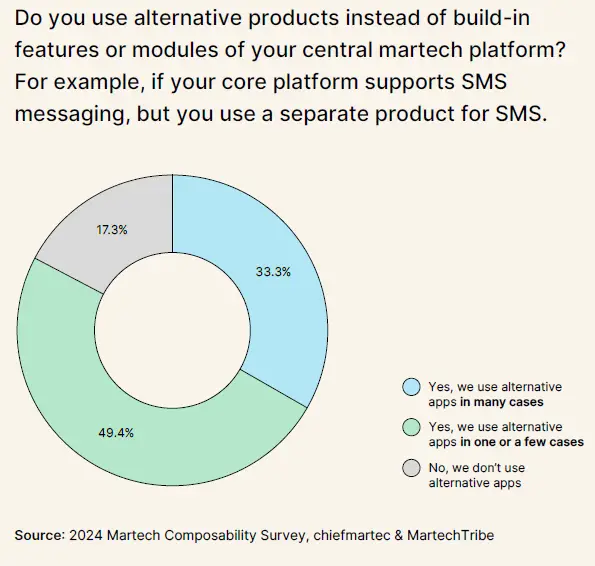
It is found out that in many cases, these vendor native functions serve the needs the marketer has. But not always. The impetus for a composable stack — one that can have different products from different vendors — is the freedom it gives marketers to use the best app that suits their purpose.
The vast majority of respondents: 82.7% have cases where they use an alternative product instead of a native feature or module in their central martech platform. 33.3% reported having many cases where they use alternative apps.
This held true for both B2B and B2C businesses.
But why does this happen?
The below info-graphic shows us the top 4 reasons why users prefer a separate app or tool instead of a composite platform for some of their operations.
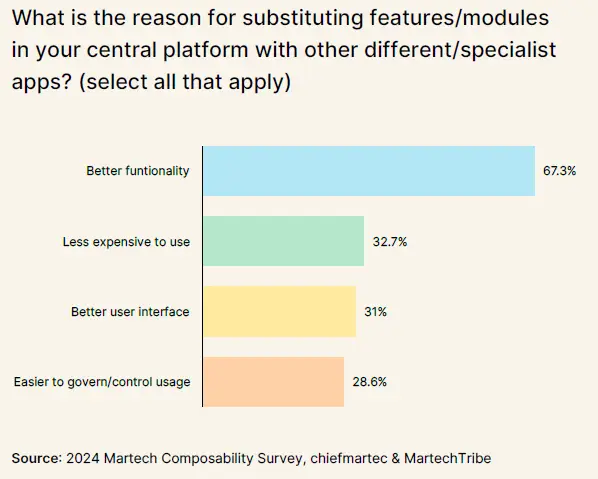
- Limited Functionality: Large platforms can’t cater to every marketer’s specific needs. Marketers often find that specialist apps offer better functionality for certain tasks. (67.3%)
- User Interface: Complex or cumbersome interfaces on large platforms can discourage users from utilizing features to their full potential. (31%)
- Cost: Using all the features of a large platform can be expensive, while specialist apps may offer the same functionality for a lower cost. (32.7%)
- Governance: It can be easier to control user access and activity within a single-purpose app compared to a large platform with many features. (28.6%)
Recent MarTech Trends
The below topics are some of the recent trends which MarTech has adopted or has began to adopted for the foreseeable future. These trends would shape the future of MarTech landscape and would have a large influence on the tools to be developed.
- All-in-One Solutions (Platform Aggregation):
While there are thousands of independent MarTech options, an all-in-one solution that connects multiple tools can save time and encourage cross-team collaboration. - Application Program Interfaces (APIs):
APIs allow platforms to increase functionality without using separate interfaces, seamlessly connecting to other software for streamlined workflows. - Artificial Intelligence (AI):
AI is improving the customer experience through chatbots, personalised recommendations, and predictive analytics, among other applications.
Conclusion
The introductory blog has provided some insights of what is the current scenario of MarTech and below infographic shows the summary of the Top MarTech Tools available for use for the marketers and businesses.
But we have barely scratched the surface of the true potential of MarTech.
MarTech can be confusing to many marketers and businesses, with so many tools and technologies to choose from it is hard to make the right choice. Hoping that the blog was able to give insights on making the correct choice for the business needs.
In the upcoming series of blogs, we will venture deeper into what are the important categories of MarTech and tools under each category, their use cases and their suitable users. This could help the marketers understand the proper selection of the tools for their needs.
There is a lot more to cover in the upcoming blogs until then stay tuned for more updates and keep yourselves busy in the world of MarTech.
Disclaimer – This blog reflects our experience of working with multiple tools over the past decade.
If you’d like to discuss how we can help enhance your Marketing Technoogy and optimize your strategies, we’d be happy to set up a consultation call. Feel free to reach out to us at alibha@daiom.in.
For more informative content and blog, follow and stay tuned to DAiOM!
Subscribe to our NEWSLETTER!


